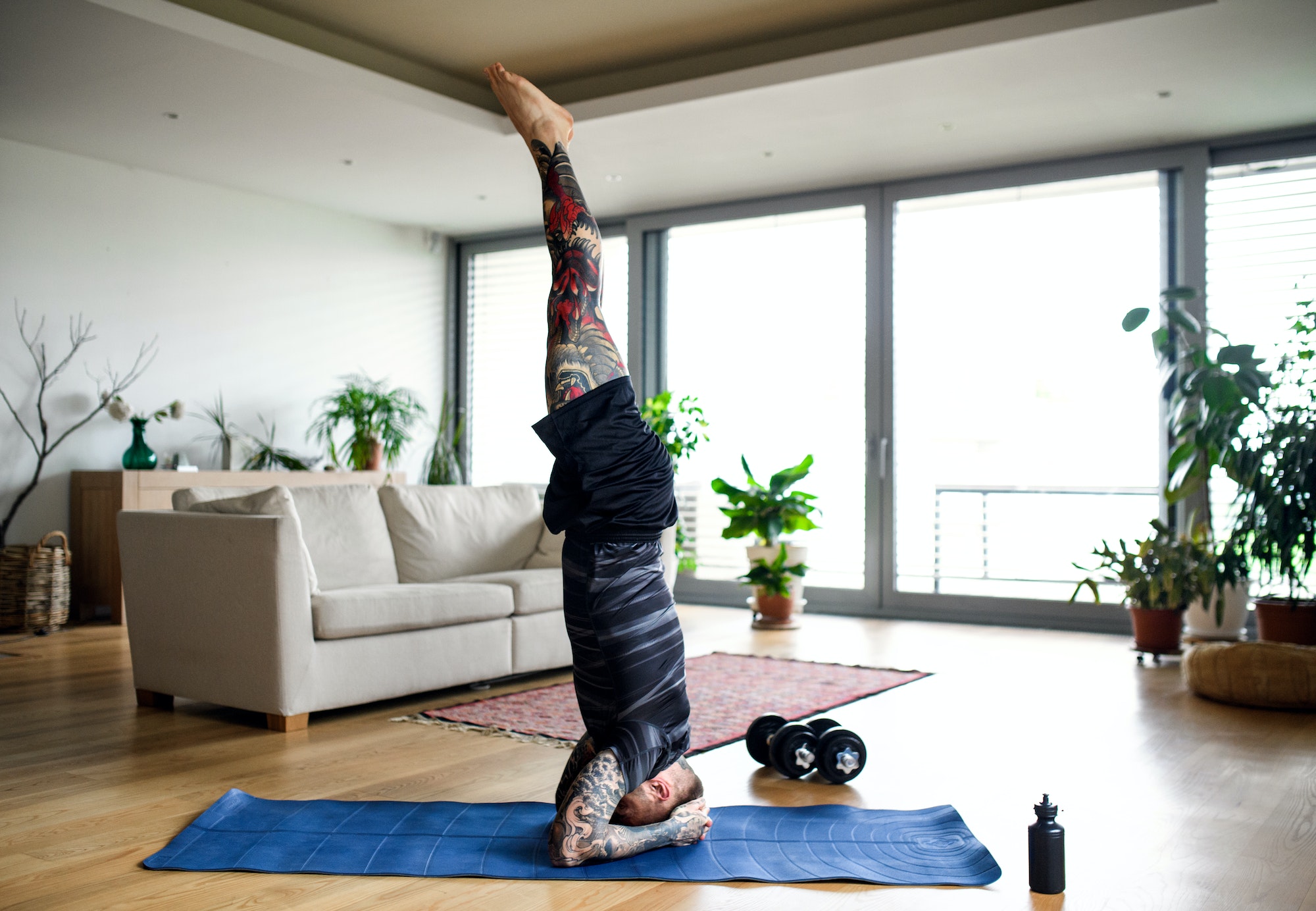For this article, we interviewed personal trainer and physical therapist Clyde Staley, PT, DPT, CSCS. Clyde is a Doctorate of Physical Therapy and a Certified Strength and Conditioning Specialist, he has over 6 years of experience training athletes and clients to increase hypertrophy and perform their best in their sport.
Home workouts have become a convenient and popular choice for individuals who aren’t able to go to the gym regularly, and for those skeptical to return to gyms since the COVID-19 pandemic began.
Something individuals often struggle with during at-home workouts is progressive overloading.
Individuals often find they’re reusing the same workouts over and over again, which causes them to plateau in their progress, as well as get bored with their training.
Progressive overload at home can be done by increasing the number of reps or sets of an exercise, increasing exercise intensity, increasing the frequency of training, decreasing rest breaks between sets, and progressing specific exercises to make them more challenging.
If an individual chooses not to purchase new equipment for at-home workouts, progressive overload can be performed by changing the parameters of the exercises they do already at home, or by changing the exercises themselves.
Below is a table that lists examples of how to progressive overload with home workouts, with one section for at-home workouts using equipment and for at-home workouts using primarily bodyweight.
| Exercise Parameter | Equipment-Based Example | Bodyweight-Based Example |
| Increase The Number of Sets Performed | Increase from 3 sets to 4 sets | Increase from 3 sets to 4 sets |
| Increase The Number of Reps Performed | Increase from 10 reps to 12 reps | Increase from 10 reps to 12 reps |
| Increase The Training Frequency | Perform 4 workouts a week instead of 3 | Perform 4 workouts a week instead of 3 |
| Decrease The Rest Time Between Sets | Decrease from 90 seconds to 60 seconds between sets | Decrease from 90 seconds to 60 seconds between sets |
| Perform Tempo Reps | Lower for 3 seconds during a goblet squat rather than 1 second | Perform a 3 second eccentric rather than a 1 second eccentric push up |
| Increase Exercise Intensity | Add weight or increase the resistance of the resistance band | Progress to an advanced variation of the exercise |
There is a lot of overlap between progressive overload in the gym compared to progressive overload at home. This is because the principle of progressive overload is consistent with all types of training, regardless of the location and equipment available.
The key to progressive overload at home is to pick a parameter to manipulate for the next session, and increase it at a rate that is appropriate and comfortable.
Adjusting Tempo Reps at Home
Progressive overload can be achieved using tempo reps to increase the intensity of an exercise. Tempo reps including slow eccentrics or prolonged isometrics can improve muscle hypertrophy, strength, and endurance.
A tempo rep involves performing a rep of an exercise at a specified tempo. Rather than performing an exercise at a standard speed, individuals will often perform a 2-5 second eccentric, or a prolonged isometric hold at the hardest part of the exercise.
Eccentric exercises can be incorporated into nearly any exercise, making them a perfect option for progressive overload at home.
Slow eccentrics are a challenging progression to increase time under tension, which results in increased demand placed on the muscles and increased subsequent adaptations to those demands.
An example of a slow eccentric would be to perform a 3-5 second lowering phase of a push up or a squat, followed by a 1-2 second concentric execution of the movement.
Fast, controlled eccentric movements are challenging to perform correctly for novice athletes, but are the type of muscle contraction that produces the greatest amount of force, and can also be utilized to progressively overload without changing other exercise parameters.
Finally, a prolonged isometric hold is another fantastic option for progressive overloading at home. This involves holding the movement in a challenging position for a prolonged period of time.
A classic example of this is a wall sit. The individual will hold a squat position with their back against a wall for a set amount of time.
This example can also be applied to multi-joint movements such as squats, lunges, and push ups. The rationale here is to increase time under tension, which increases the demand and subsequent adaptations of our muscles.
Increasing Exercise Intensity At Home
The simplest way to progressive overload is to increase the intensity of the exercise. However, with limited equipment at home, individuals must find other ways to increase exercise intensity at home.
One solution for progressive overloading by increasing exercise intensity is to progress the exercise itself. Most bodyweight exercises have many progressions that can be performed or worked up to.
Some examples of exercise intensity progressions are shown below:
- Air Squat > Split Squat > Single-leg eccentric squat > pistol squat
- Push up > foot elevated push up > spiderman push up > clap push up
- Lunge > Lateral lunge > lunge isometric > plyometric lunge
Another way to increase intensity is to add resistance. This most commonly occurs with increasing the weight of dumbbells or resistance bands, but if that’s not possible at home, there are other ways to provide extra resistance.
For example, using household items such as water gallons, cinder blocks, or other heavy, dense objects, can increase resistance in place of dumbbells or medicine balls for exercises that would normally use those.
Understanding Periodization
Periodization is the process of strategically adjusting exercise parameters in a given program. All of the aspects of progressive overload discussed above are examples of periodization, and are all effective for progressive overload at home.
Linear periodization involves slowly increasing exercise intensity over time, without adjusting other parameters such as sets and reps.
This type of periodization is useful for fast improvements in strength and hypertrophy.
Nonlinear periodization involves adjusting parameters more frequently, most often by increasing intensity but decreasing the number of reps performed.
This process often leads to slower gains but is highly effective for breaking training plateaus.
No form of periodization is better for general athletes looking to improve their strength and body composition. Both have been shown to produce significant benefits, and can be applied for home exercise.
When To Progressive Overload
While progressive overload is one of the best ways to ensure continued progress and prevent plateaus, it is important to determine when it is appropriate to progressive overload.
Overloading too much too quickly increases the risk of burnout, overtraining, and injury.
The Modified Borg RPE Scale is a great tool for individuals to use when determining exercise intensity. The scale, as well as descriptions for each level, is below:
| Level | Description |
| 0 | Rest |
| 1 | Very Very Light |
| 2 | Very Light |
| 3 | Light |
| 4 | Moderate |
| 5 | Somewhat Hard |
| 6 | Hard |
| 7 | Very Hard |
| 8-9 | Extremely Hard |
| 10 | Maximal Exertion |
When an individual performs a set of an exercise, they may rate their subjective level of exertion on this 0-10 scale.
The individual’s goals should coincide with their RPE. For example, if the goal is hypertrophy, the RPE for their training should stay in the 6-8 range. For strength goals, the RPE range will likely be higher, in the 8-10 range.
For progressive overloading at home, the right time to progress is when an individual identifies their RPE is decreasing when performing an exercise with the same parameters.
An example of this is provided below:
- On day one, an individual performs 3 sets of 10 reps of bodyweight lunges with 60 second rests between sets and identifies their RPE as an 8.
- They continue to perform this exercise with the same parameters twice a week for two weeks. In the last session, they identify their RPE as a 5.
- This is a good time to progress one of the parameters. The athlete chooses to progress from sets of 10 to sets of 12.
- In the next session, their RPE is an 8, meaning the new parameters for bodyweight lunges will be 3 sets of 12 with 60 second rest breaks.

Austin is the author of loveatfirstfit.com and a personal trainer with extensive knowledge in nutrition. Austin is passionate about helping others to find a suitable healthy lifestyle and feel good about themselves. Austin’s goal is to help people push their limits and achieve their physical performance.

